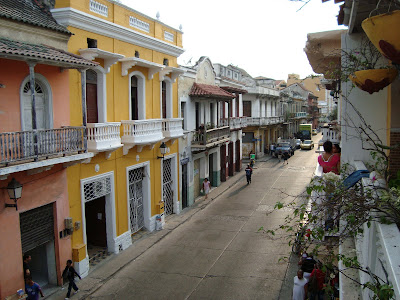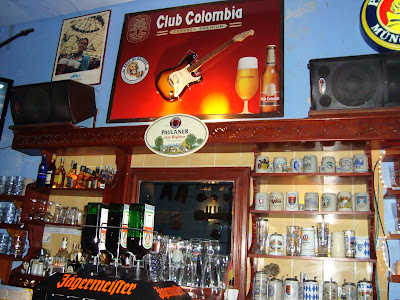
From Medellin to Cartagena, the difference in price between a 17 hour bus ride and a 3 hour flight was only around 15 US dollars, so it was a fairly easy decision. Stepping off the plane, I immediately noticed the tropical heat - especially having not felt it for so long.

Cartagena de Indias, to give it its full name, is split between the old historical centre and the new city. The old town is full of beautiful colonial buildings and is now a UNESCO World Heritage site. This was the view from the balcony in my first hostel.

I'd met a guy on the plane - he was very patient to tolerate an hour of my rusty Spanish - who said there was a German bar/restaurant that had live music on Thursdays (the day I arrived) so I took some people from the hostel. It was an interesting and fun mix of Colombian music with AC/DC and other rock. Sorry Bob, they didn't have any Sabbath in their locker.

The old city was founded in 1533 and is named after a place from where many of the sailors for the founding commander Pedro de Heredia came in Spain. Almost from the start, its wealth and fame (owing to its importance as a centre for sailing precious metals from South America to Europe) attracted unwanted attention from invading armies and pirates, including an invasion by Sir Francis Drake. Spain poured money in to bolster its defences and constructed a system of walls around the city.

In the 17th century Spain continued strengthening the city's defences and constructed fortresses to repel land attacks, the most impressive being the Castillo San Felipe de Barajas, which still sits in a commanding position overlooking the city today.

Being on the Caribbean coast, there's more Afro influence here and you see women walking around with baskets of fruit on their head. The music is more Afro-Caribbean and there was a Cuban joint which was fun.

It's too hot and the sun is too strong to be walking around too much around midday, but it´s small enough that you can easily walk around in a couple of days, even allowing for a siesta.

The area most hostels are in is Getsemani, the poor area of the old town. It's chaotic and interesting, with men of all ages pushing enormous carts laden with all manner of produce and shouting out in competing monotone voices what they've got to offer. The downside is that at night there are a lot of prostitutes hanging around in the street with their pimps, and you get hassled constantly by drug dealers. A typical exchange, translated, runs like this:
"Hey amigo, what do you need?"
"Nothing, thank you"....keep walking.....
"But I'm the boss, I can get you the best cocaine, marijuana, girls, whatever" (with this many bosses it must be the flattest management hierarchy in the world)
"Really I'm fine, thank you. Good luck"..... keep walking.....
"I give you a good price and it's the best"
"Listen. I don't want anything, I don't need anything. Thank you. Good luck"....
At which point they finally leave you alone. So it's not aggressive, they don't push you up against a wall and make you buy anything or try to rob you, but it still gets on your tits after a while.

Taxis hurtle down the streets, beeping frantically as they go. This is necessary beeping, seeing as many locals amble out onto the street with almost total disregard for the odds of coming off better than a car if a collision should happen. Coming from a man who was hit by a car in London a couple of years ago, I admit this is strange for me to say.
In the evenings, the nicer part of the old city is full of people out enjoying an evening drink and listening to the cacophony of Caribbean music bursting forth from the city´s bars.

Inquest
I always got confused between the Spanish Conquest and the Spanish Inquisition, but have a better idea now. I will save a post on the Conquest until I'm in Peru. In terms of Inquisition, the Spanish set up tribunals or Inquisitions to question those suspected of witchcraft or other activities that might be offensive or a threat to catholicism. Two tribunals were set up in South America, one here in Cartagena. Anyone could throw a piece of paper with someone´s name written on it, anonymously, into the window of the building housing the tribunal. Anyone could cast allegations about others, so you´d imagine plenty of allegations were made to hurt business rivals or settle old scores. The list of questions they asked suspected witches is comical and worth reproducing here:
1. Since when have you been a witch?
2. Why did you become a witch?
3. How did you become a witch and what happened on that occasion?
4. Whom did you choose as your partner?
5. What is his/her name?
6. What is the name of your master amongst the evil spirits?
7. What is the oath that you have had to render to him?
8. How and under what terms have you done it?
9. What fingers did you have to rise?
10. Where did you celebrate your wedding?
11. What demons and people attended your wedding?
12. What foods did you eat?
13. How was it served on the table?
14. Where you also sitting down at the table?
15. What kind of music was played? What were the dances? Did you not dance?
16. Who was assigned as your partner at the ceremony?
17. What mark did your partner make you on your body?
18. What evils have you caused? To whom and how?
19. Why did you cause this evil?
20. How can it be remedied?
21. What kind of herbs, potions, and other means can be used to cure that curse?
22. To which children have you cast the spell of the "evil eye" and why have you done it?
23. What animals have you killed or put under a curse? And why have you done it?
24. Who are your associates for/in evil?
25. Why does the devil strike you blows at night?
26. How do you compose/prepare your ointment or witches' brews?
27. How can you fly through the air?
28. What words do you pronounce when you fly?
29. Are you flying so fast?
30. Who has taught you to fly?
31. What worms and caterpillars/slugs have you created?
32. What do you use to make these harmful/noxious animals (worms and caterpillars/slugs) and how are they created?
33. Has put the devil a bow/ribboon on to your curses/oaths?
The museum in Cartagena dedicated to the Inquest was interesting and kind of mind blowing as well. Some of the instruments of torture and death don't leave much to the imagination. It was interesting to see they used a form of what the CIA now cheerfully refer to as "waterboarding", and the fact that someone could be locked up by these Inquisitions on the basis of no evidence also reminds me of Guantanamo. So maybe in some ways we're still stuck in the dark ages.

Kidnapping & Terrorism
The bad reputation Colombia is trying so hard to shake off comes largely from its historical problem with guerilla warfare and kidnapping. In 1948 a populist Liberal politician was murdered, triggering consequences of staggering proportions. In the following decade, more than 200,000 people were killed in brutal civil conflict - La Violencia. In 1958 the Liberals and the Conservatives agreed to form a unity government to put an end to the conflict. However, many rural and peasant Colombians felt that the new setup was a continuation of what had gone before - a preservation of the status quo for wealthy Colombians, the influence of the United States and the loss of natural resources to multinationals - and following the end of La Violencia, government forces were attacking rural communities and carrying out state-backed murder on a horrific scale. The birth of guerilla movements to resist this ongoing violence was perhaps inevitable.
The FARC is the most infamous group and is still active, though there were more groups in the past. Initially concentrated only in rural areas in the east and southeast of Colombia, it grew steadily but slowly until the 80's. Having initially rejected participation in the narco trade, it recognised the funding potential to be had in processing and trafficking cocaine for consumption in the West. By the 1990s its numbers grew and it was fighting the government's forces in more areas, not just rural ones.

Since 2002, when President Uribe first took office, the FARC has been on the wane. Uribe ran on an anti-FARC platform, his own father having been killed in a kidnapping attempt. A combination of government actions and loss of popular support seem to have succeeded in marginalising the group, whose numbers are said to have fallen to around 11,000 members. There are, however, many prisoners still being detained by the FARC and other guerilla groups, and the number of minors fighting in these groups is estimated at around 30-40 per cent. It's impossible to tell whether they will continue to be marginalised and disintegrate, or whether this is just a period of calm. There are Presidential elections coming up so it will be interesting to see which direction things go.
Playa Blanca
Onto brighter things, a group of us caught a boat to a beautiful beach nearby - Playa Blanca ("White Beach"). We caught a cargo boat out there which was the customary shambles - all manner of people crammed in, while the boat's owner waited for yet more to be crammed in, along with bags, boxes and cartons of eggs, meat and other essentials. Playa Blanca relies on these boats to stock up from day to day. We finally set off for the 40 minute blast across the bay and to Barù where the beach is located. But the coastguard had other ideas and pulled us over to an area in the naval base, where everyone had to get out so that dogs could sniff the boat for drugs. They also sniffed a few of the passengers. It was amusing to see some people edging nervously away from the dogs. Given the all clear, we were back in the boat and finally got away to the beach.

It was worth the wait. Beautiful water and, like the name suggests, white sand. After the tourist boats left at around 4pm we had the place to ourselves. We slept in hammocks and ate fresh fish and chicken which was caught and prepared for us by the guy who ran the hammock place. It was as relaxed a place as it can get.

The weather wasn't so good the next day, so we came back to Cartagena to sort out some admin before heading further up the coast. I've been hanging out with a group of folks from Argentina and Chile, so it's helpful to practice my Spanish. When they talk slowly that is......




No comments:
Post a Comment